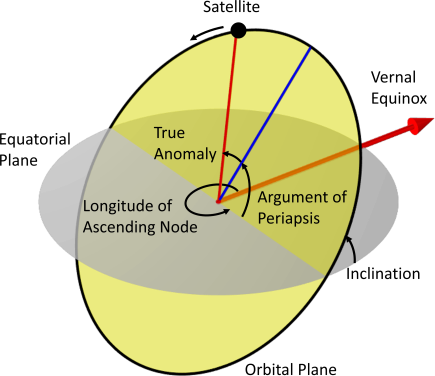To compute the orbit, the six Keplerian elements are used as in Figure 4-24: the eccentricity (
e), argument of periapsis (
ω), semi-major axis (
a), inclination, (
i) and the longitude of the ascending Node, (
Ω). The beginning of the simulation can start at any point on this ellipse, as defined by the true anomaly at the simulation start time (
ν0).

where the orbital period is  and t0
and t0 is the time that it takes for the spacecraft to get from the perigee to
ν0. This time is computed by integrating the swept area of the ellipse in cylindrical coordinates, centered at the planet:
where A is the total area of the orbital ellipse and the ellipse radius as a function of the true anomaly is:
where  and Jn
and Jn are Bessel functions. In practice, only a finite number of terms, depending upon the eccentricity, in this infinite series need to be considered.
where [ x ] is the function that rounds to closest integer or to closest number.
Once the true anomaly over time is known, we know the position, XECS, in the ECS from the longitude of ascending node, the inclination, and the argument of periapsis:
where TECS is the transformation matrix from the orbital plane coordinate system to ECS:
When || XSNP || < Rplanet and if the spacecraft is in front of the solar normal plane
es ⋅ XECS > 0, the spacecraft is in eclipse.

